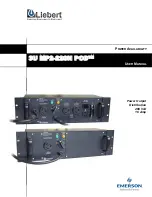
USING THE WEB INTERFACE
EATON
Managed ePDU
t
User’s Guide
S
164201xxx Rev 1
DRAFT 10−OCT−2008
50
Installing a Certificate
Once the CA has provided you with a digital certificate, you must install it on the
ePDU. To do this:
1.
Verify that a certificate has been created.
2.
Select
Device Settings
, and then select
Certificate
. The second page of the Server
Certificate Management page displays (see Figure 47).
3.
Type the path and name of the certificate file in the
SSL Certificate File
field, or
click
Browse
and go to the location of the file and select it.
4.
Click
Upload
. The certificate is installed on the ePDU.
Setting Up External User Authentication
For security purposes, users attempting to log into the ePDU must be authenticated.
You can use the local database of user profiles in the ePDU, or you can use the
Lightweight Directory Access Protocol (LDAP) or the Remote Access Dial−In User
Service (RADIUS) protocol.
By default, the ePDU is configured for local authentication. If you stay with this
method, you do not have to do anything other than create user profiles for each
authorized user. If you prefer to use an external LDAP or RADIUS server, you have to
provide the system with information about the server.
Keep in mind that you still need to create user profiles for users who are
authenticated externally. This is because the user profile determines the user group
to which the user belongs, and the user group determines the user’s system and
outlet permissions.
Summary of Contents for Managed ePDU
Page 1: ...Managed ePDU User s Guide...
Page 4: ......
Page 10: ...TABLE OF CONTENTS EATON Managed ePDUt User s Guide S 164201xxx Rev 1 DRAFT 10 OCT 2008 vi...
Page 16: ...SAFETY WARNINGS EATON Managed ePDUt User s Guide S 164201xxx Rev 1 DRAFT 10 OCT 2008 6...
Page 20: ...RACK MOUNTING THE EPDU EATON Managed ePDUt User s Guide S 164201xxx Rev 1 DRAFT 10 OCT 2008 10...
Page 128: ......
Page 129: ...164201xxx1 164201xxx 1...
















































